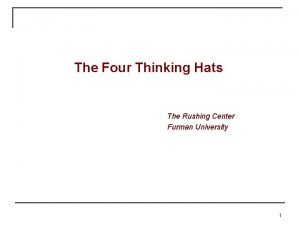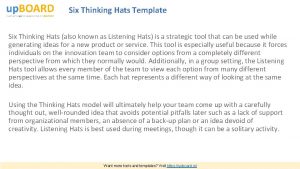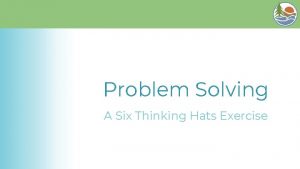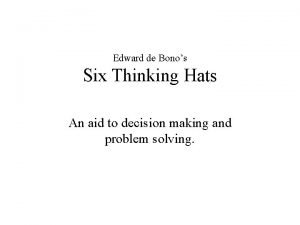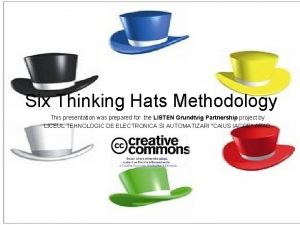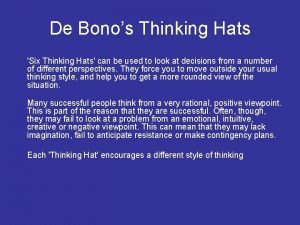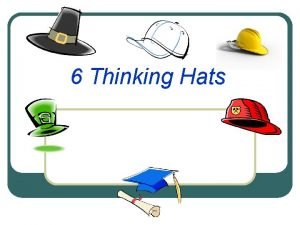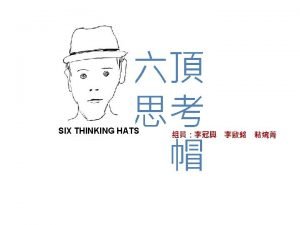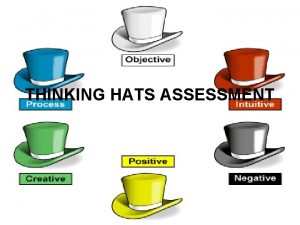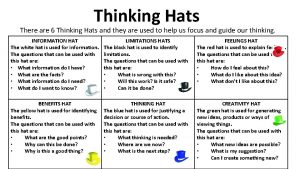The Four Thinking Hats The Rushing Center Furman













- Slides: 13

The Four Thinking Hats The Rushing Center Furman University 1

Herrmann Brain Dominance Index Ned Herrmann (1922 -1999), Manager of Management Education for GE, conducted research on how to maintain or increase an individual’s productivity, motivation, and creativity Sponsored by GE, he developed and validated the Herrmann Brain Dominance Index (HBDI), a scored analyzed survey designed to measure an individual’s thinking and learning preferences The HBDI is based on a comprehensive four part Whole Brain Model 2

We All Use All Four Quadrants But each person will prefer certain quadrants over others – this preference is what the HBDI attempts to measure Left Brain Right Brain 3

“Blue” Quadrant Preference Blue LOGICAL ANALYTICAL Gathering Facts HOLISTIC INTUITIVE FACT BASEDINTEGRATING SYNTHESIZING QUANTITATIVE ORGANIZED INTERPERSONAL SEQUENTIAL Analyzing data Problem solving logically Arguing rationally Measuring precisely Understanding technical elements FEELING BASED PLANNED KINESTHETIC DETAILED EMOTIONAL 4

“Green” Quadrant Preference LOGICAL HOLISTIC ANALYTICAL INTUITIVE FACT BASED INTEGRATING ORGANIZED SYNTHESIZING QUANTITATIVE INTERPERSONAL SEQUENTIAL FEELING BASED PLANNED KINESTHETIC Green DETAILEDEMOTIONAL Approaching problems practically Reading the fine print in documents and contracts Organizing & keeping track of essential data Developing detailed plans and procedures Articulating plans in an orderly way 5

“Red” Quadrant Preference LOGICAL ANALYTICAL Anticipating how others HOLISTIC INTUITIVE FACT BASED INTEGRATING INTERPERSONAL QUANTITATIVE SYNTHESIZING FEELING BASED ORGANIZED SEQUENTIAL KINESTHETIC PLANNED DETAILED EMOTIONAL will feel Intuitively understanding how others feel Picking up on non-verbal cues of interpersonal stress Persuading Conciliating Understanding emotional elements Considering values Red 6

“Yellow” Quadrant Preference HOLISTIC LOGICAL Yellow INTUITIVE ANALYTICAL INTEGRATING FACT BASED QUANTITATIVE SYNTHESIZING INTERPERSONAL ORGANIZED SEQUENTIAL FEELING BASED PLANNED KINESTHETIC DETAILED EMOTIONAL Seeing the big picture Recognizing new possibilities Integrating new ideas and concepts Bending or challenging established policies Synthesizing dissimilar elements into a new whole Problem solving in intuitive ways 7

Four Thinking Hats The colors of the four hats correspond to the four colors in the Herrmann Brain Dominance Index. We all have the ability to use these four quadrants of our brain – in other words we can all put various color hats on if we want to. If we don’t think about it consciously, we are inclined to wear only one or two of these hats – our preferred quadrant(s) – in our problem-solving. The four hats are a great communication tool to ensure that team members engage all four quadrants – hence we may get some insights we would have otherwise missed! 8

The Yellow Hat When you are wearing your yellow hat, you ask questions like the following: What are the big picture issues here? What if. . . ? Can you create other ways to do this? How could you frame the problem differently? What new ideas can we brainstorm about? What other possibilities for a solution are there? 9

The Blue Hat When you are wearing your blue hat, you ask questions like the following: Who, What, When, Where? What do we know about this issue? What are the most relevant facts about the issue? What additional things do we need or want to know about it? How can we analyze the information we have collected to reach a logical conclusion about our action/decision? 10

The Red Hat When you are wearing your red hat, you ask questions like the following: What are your feelings on the issue? What action/decision would you prefer based on your feelings? What prejudices are present? What is your hunch about the issues and the discussion under consideration? What is your gut feeling about the proposed solutions or action? What does your intuition tell you? 11

The Green Hat When you are wearing your green hat, you ask questions like the following: What steps are needed to implement the proposed solution or decision? How should these steps be organized? What are the likely road blocks and how can we ensure that they will be handled? What resources do we need and how will we garner them? Can we devise an organized plan to accomplish our agreed upon goal(s)? 12

Using the Four Thinking Hats A leader can use the four thinking hats to facilitate better meetings: q Solicit different kinds of thinking from everyone. “Okay, let’s all put on our yellow hats for a moment …” q Move off a stalled subject (or person) without offense. “Okay, Bob has given us a great green hat summary. Let’s now try examining the issue with our red hats on. Linda, could you get us started? …” q Diffuse a tense situation by inserting a little humor at times. “Well, we’ve surely examined the blue hat view thoroughly. Let’s shift hats for a little breather. George. . . ” The four hats are also a way to encourage participation by everyone, without making anyone uncomfortable. The bottom line is that the four hats can elicit whole brain thinking that a group might otherwise not engage in. 13
